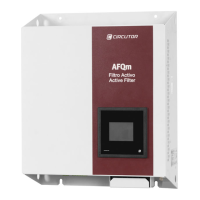16
AFQm
Instruction Manual
It should be noted that, depending on the installation conditions in the cabinet and in the room where
this is placed, the outflows of hot air may be sucked back in by the device’s fans, causing a feedback
of hot air that will lower the performance of the device.
It is also necessary to bear in mind the power dissipated by the device when choosing where to install
it, to ensure proper air recirculation, to make sure that the intake air is a suitable temperature. See
“11. TECHNICAL FEATURES”.
Table 9: Ventilation distances: Rack-type AFQm.
Ventilation distances : Rack-type AFQm
300 mm 300 mm
3.2.1.3.- Cabinet-type AFQm
The cabinet-type AFQm uses a forced ventilation cooling system, with an air inlet on the front panel
and an air outlet at the back of the device.
The ventilation grille at the top must not be blocked, leaving enough space to the ceiling to allow the
heat to dissipate. The distance depends on the characteristics of the installation site.
There is no need to leave space between the sides or at the back of the cabinet; they can be installed
next to other cabinets and against a wall.
Table 10: Ventilation distances: Cabinet-type AFQm.
Ventilation distances : Cabinet-type AFQm
300 mm
Note: At maximum power, the 100A module provides an air flow of 375 m
3
/h. At maximum power, the
70A module provides an air flow of 425 m
3
/h.

